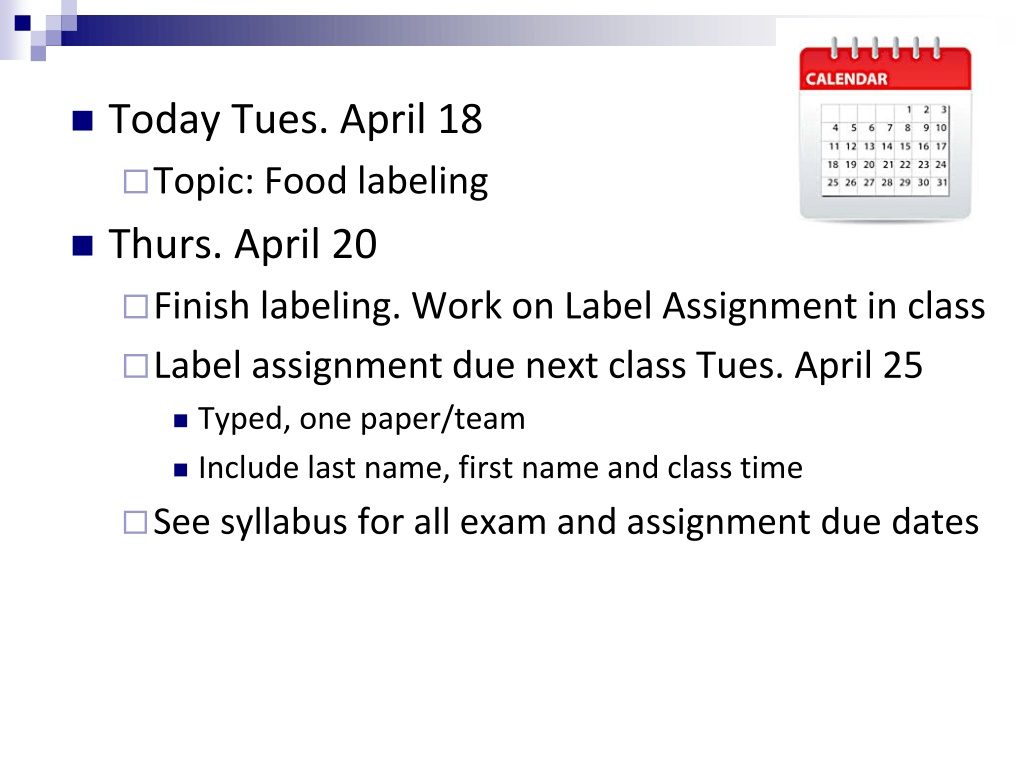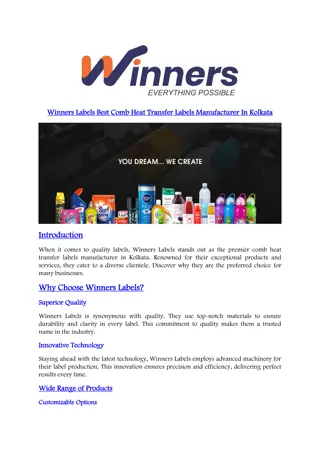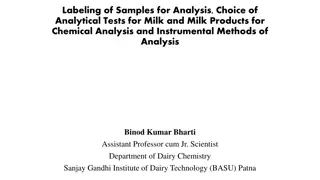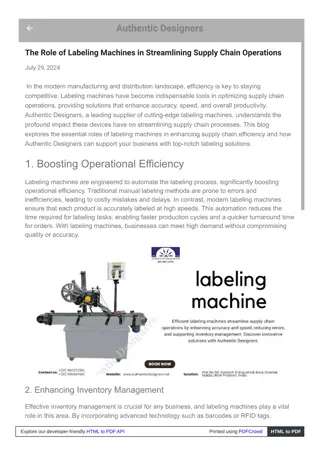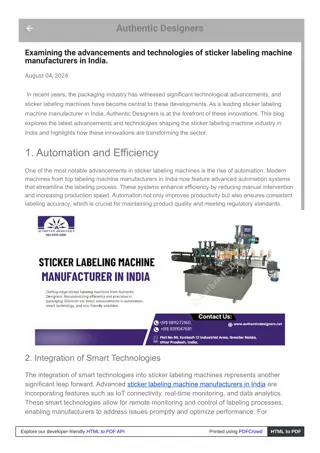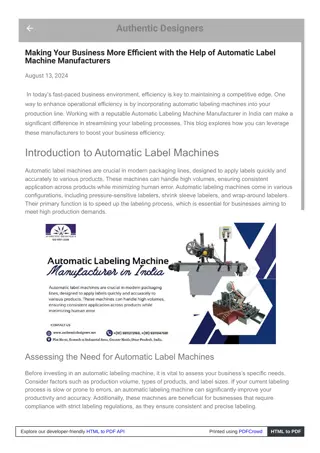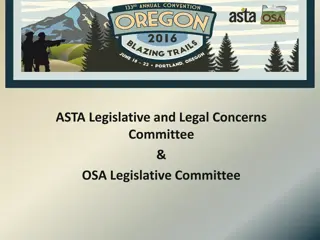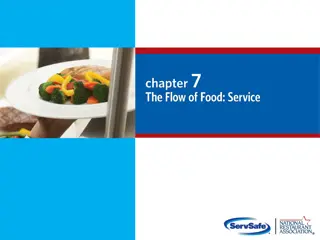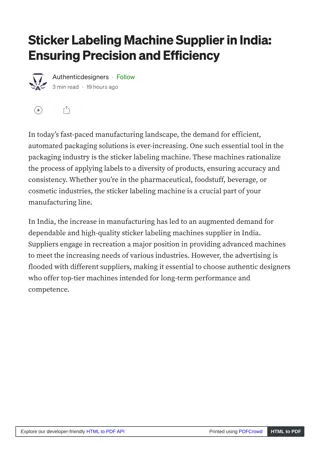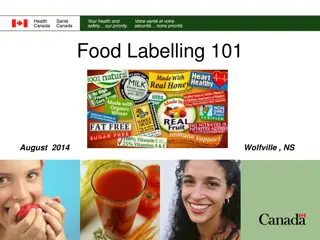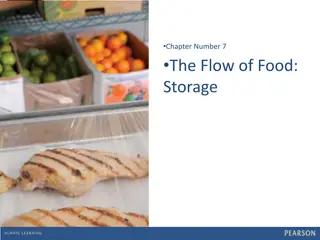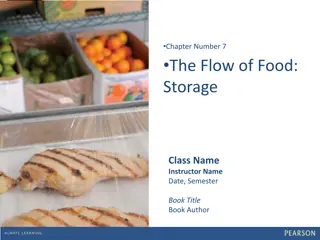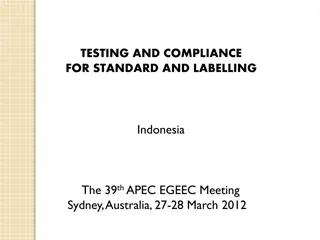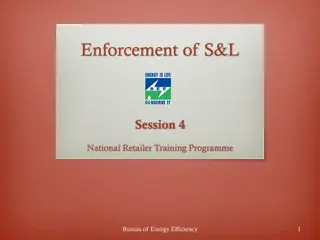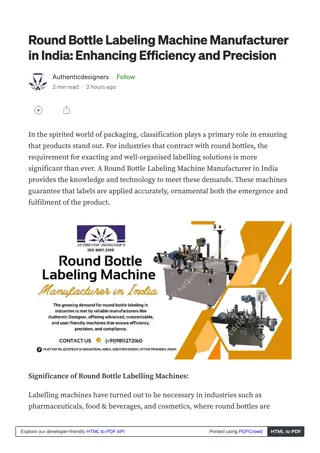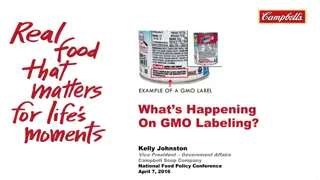Understanding Food Labeling: A Comprehensive Overview
Dive into the world of food labeling to understand its basics, regulations, and tips for effective usage. Explore the role of the FDA and USDA, deciphering nutrition facts panels, ingredient lists, and the nuances of labeling accuracy. Unravel the complexities of fresh foods, meat products, and the evolving landscape of consumer protection in the food industry.
Download Presentation

Please find below an Image/Link to download the presentation.
The content on the website is provided AS IS for your information and personal use only. It may not be sold, licensed, or shared on other websites without obtaining consent from the author. Download presentation by click this link. If you encounter any issues during the download, it is possible that the publisher has removed the file from their server.
E N D
Presentation Transcript
Today Tues. April 18 Topic: Food labeling Thurs. April 20 Finish labeling. Work on Label Assignment in class Label assignment due next class Tues. April 25 Typed, one paper/team Include last name, first name and class time See syllabus for all exam and assignment due dates
Deciphering Labels-part l The Basics .
Labeling Overview Intended Purpose Inform consumer Manufacturer s purpose Make a sale! Nutrition Facts panel info reliability is good! Regulated by: Food and Drug Admin. (FDA) US Dept. of Agriculture (USDA) % Daily Value (DV) Use to compare products Based on high quality data
USDA-regulatesmost fresh foods! Currently, labeling is mostly voluntary Eggs, fresh fruit/vegetables, milk, meat
Most fresh meat is USDA monitored No! USDA Lean 4 oz. serving <10 g fat < 95 mg cholesterol Are the products truly lean and/or low-fat? %fat %Cal What are %Cal from fat in these items? Yes, lean! Illustration 4.4, p. 4-5
% fat % calories on meat products 20% fat means ~70 % of Calories from fat 7% fat means ~43% of Calories from fat The 7% fat product is lean Neither product is low fat (<3g fat/serving) Both ~high fat/sat fat, high protein/iron foods Meat is tasty because of the fat in it!
Food & Drug Administration (FDA) Regulates most foods, drugs and supplements 1990 Nutrition Labeling and Education Act Goal: Provide consumer accurate food info Reality: Caveat Emptor! Buyer Beware! Laws improved to protect consumer Labels changed to work around the laws!
A quick start for effective label use Two parts are your friend! Nutrition Facts panel Ingredient list Be skeptical of all other label info Consider it to be advertising
Overview: current Facts Panel Macaroni and Cheese Start here 5/20 Rule 5% DV or less is low 20% DV or more is high Limit these (gold) Get enough of these (blue) Footnote
What can you learn from this list? INGREDIENTS: Milled corn, sugar, enriched flour {wheat flour, reduced iron, niacinamide (vit B3), riboflavin (vit B2), thiamine hydrochloride (vit B1) and folate}, corn syrup, molasses, salt, honey, partially hydrogenated vegetable oil (one or more of the following oils; coconut, cottonseed or soybean oil), sodium ascorbate and ascorbic acid (vit C), niacinamide, zinc oxide , BHT (preservative), annato, folic acid, vitamin D and B-12.
Ingredients-listed high to low by wt. INGREDIENTS: Milled corn, sugar, enriched flour {wheat flour, reduced iron, niacinamide (vit B3), riboflavin (vit B2), thiamine hydrochloride (vit B1) and folate}, corn syrup, molasses, salt, honey, partially hydrogenated vegetable oil (one or more of the following oils; coconut, cottonseed or soybean oil), sodium ascorbate and ascorbic acid (vit C), niacinamide, zinc oxide , BHT (preservative), annato, folic acid, vitamin D and B-12.
What is Sugar Splitting? INGREDIENTS: Milled corn, sugar, enriched flour {wheat flour, reduced iron, niacinamide (vit B3), riboflavin (vit B2), thiamine hydrochloride (vit B1) and folate}, corn syrup, molasses, salt, honey, partially hydrogenated vegetable oil (one or more of the following oils; coconut, cottonseed or soybean oil), sodium ascorbate and ascorbic acid (vit C), zinc oxide, BHT (preservative), annato, folic acid, vitamin D and B-12.
Sugar Splitting is deceptive! INGREDIENTS: Milled corn, sugar, enriched flour {wheat flour, reduced iron, niacinamide (vit B3), riboflavin (vit B2), thiamine hydrochloride (vit B1) and folate}, corn syrup, molasses, salt, honey, partially hydrogenated vegetable oil (one or more of the following oils; coconut, cottonseed or soybean oil), sodium ascorbate and ascorbic acid (vit C), zinc oxide, BHT (preservative), annato, folic acid, vitamin D and B-12. Are sugars natural or added?
Goal: ~25g/d women ~35 g/d men Added Sugars INGREDIENTS: Milled corn, sugar, enriched flour {wheat flour, reduced iron, niacinamide (vit B3), riboflavin (vit B2), thiamine hydrochloride (vit B1) and folate}, corn syrup, molasses, salt, honey, partially hydrogenated vegetable oil (one or more of the following oils; coconut, cottonseed or soybean oil), sodium ascorbate and ascorbic acid (vit C), zinc oxide, BHT (preservative), annato, folic acid, vitamin D and B-12. All are added! Stand alone ingreds to sweeten
Most Common Additives?? INGREDIENTS: Milled corn, sugar, enriched flour {wheat flour, reduced iron, niacinamide (vit B3), riboflavin (vit B2), thiamine hydrochloride (vit B1) and folate}, corn syrup, molasses, salt, honey, partially hydrogenated vegetable oil (one or more of the following oils; coconut, cottonseed or soybean oil), sodium ascorbate and ascorbic acid (vit C), zinc oxide, BHT (preservative), annato, folic acid, vitamin D and B-12.
Most Common Additives!! INGREDIENTS: Milled corn, sugar, enriched flour {wheat flour, reduced iron, niacinamide (vit B3), riboflavin (vit B2), thiamine hydrochloride (vit B1) and folate}, corn syrup, molasses, salt, honey, partially hydrogenated vegetable oil (one or more of the following oils; coconut, cottonseed or soybean oil), sodium ascorbate and ascorbic acid (vit C), zinc oxide, BHT (preservative), annato, folic acid, vitamin D and B-12.
Partial Hydrogenated Oilgood or bad? trans fat PHO=> INGREDIENTS: Milled corn, sugar, enriched flour {wheat flour, reduced iron, niacinamide (vit B3), riboflavin (vit B2), thiamine hydrochloride (vit B1) and folate}, corn syrup, molasses, salt, honey, partially hydrogenated vegetable oil (one or more of the following oils; coconut, cottonseed or soybean oil), sodium ascorbate and ascorbic acid (vit C), zinc oxide, BHT (preservative), annato, folic acid, vitamin D and B-12.
Bad!! Trans Fat is NOT Heart Healthy INGREDIENTS: Milled corn, sugar, enriched flour {wheat flour, reduced iron, niacinamide (vit B3), riboflavin (vit B2), thiamine hydrochloride (vit B1) and folate}, corn syrup, molasses, salt, honey, partially hydrogenated vegetable oil (one or more of the following oils; coconut, cottonseed or soybean oil), sodium ascorbate and ascorbic acid (vit C), zinc oxide, BHT (preservative), annato, folic acid, vitamin D and B-12. Note: Found in processed foods with partially hydrogenated oil (PHO) and naturally in beef/beef byproducts. Less is best.
What does enriched mean? INGREDIENTS: Milled corn, sugar, enriched flour {wheat flour, reduced iron, niacinamide (vit B3), riboflavin (vit B2), thiamine hydrochloride (vit B1) and folate}, corn syrup, molasses, salt, honey, partially hydrogenated vegetable oil (one or more of the following oils; coconut, cottonseed or soybean oil), sodium ascorbate and ascorbic acid (vit C), zinc oxide, BHT (preservative), annato, folic acid, vitamin D and B-12.
Enriched? Think depleted! whole grain heavily processed grain nutrient loss (i.e. vit, min, fiber, etc.) add back some of lost nutrients enriched grain
Enriched: Red flag-heavily processed Generally enriched foods are not top tier, nutrient dense (ND) foods ND= lots of nutrients/calorie Examples: white rice, white bread and many (most?) cereals use enriched grain (wheat, corn, rice)
Bring in the fortifications! Fortification is a red flag for highly processed One+ nutrients added in amount greater than present before processed Common in cereals Sets stage for deceptive nutrient claims Increase risk of exceeding upper limit toxicity (UL). Can be dangerous!
Name Game Deceptions Beware of processed berry products. Berry waffles/yogurt/drinks may have no berries! Read ingredient list for if/what fruit actually added
More tricky names Juice Drink Orange Drink Mostly sugar-water, flavored w/some real juice 100% Orange Juice The Real Deal : )
Legal (but confusing) Terms Change is coming! Healthy-Limits cholesterol/fat/sodium/sat.fat No limit on sugar. nuts, salmon, avocado fail---pudding in a cup passes?!? Natural- No synthetic/artificial ingredients allows GMO s/antibiotic use in animals?!? Free Range-No legal definition .yet! Fresh-No preservatives, raw, never frozen, canned or heated. This is the only well defined term of the list!
Legal, but deceptive! Beware of label claims Some true, some bogus. Tough to differentiate. ADVICE! Ignore all claims and descriptors ! Remember! Product claims govt. guarantee a product is healthy.
Next Class With a partner, work on labelling assignment in class Due next class, Tues. April 25 We will finish-up label topic following in-class work time
